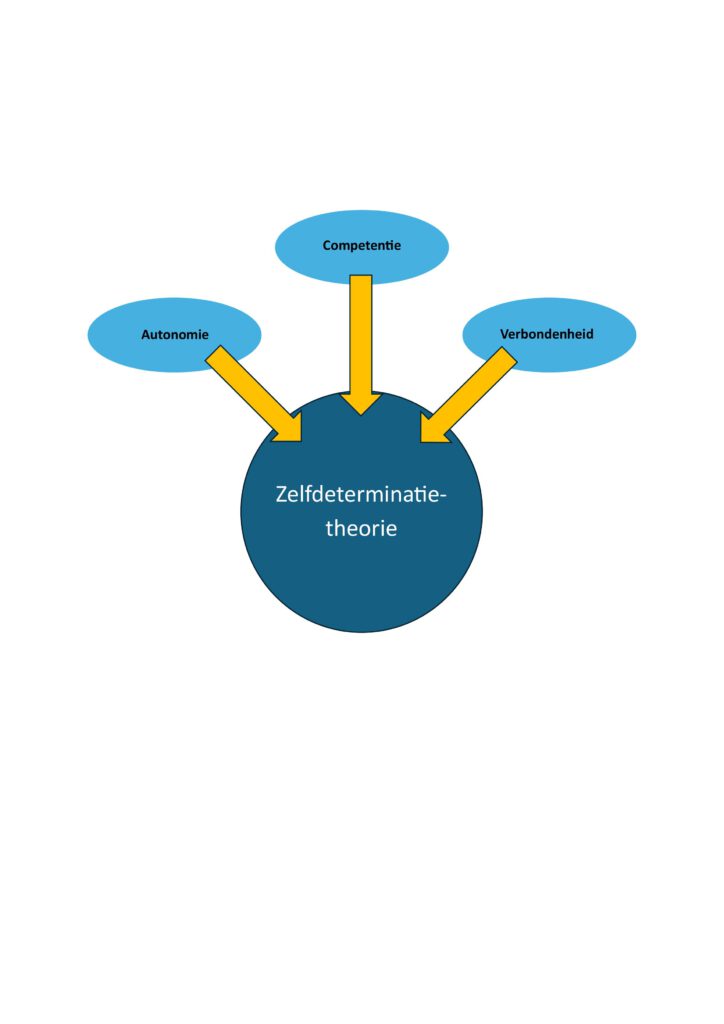Theorie en Motivatie
Zelfdeterminatietheorie in de sport
De Zelfdeterminatietheorie van Deci en Ryan (2000) helpt verklaren waarom intrinsieke motivatie zo krachtig is. Volgens deze theorie worden mensen pas echt gemotiveerd wanneer aan drie psychologische basisbehoeften wordt voldaan:
Autonomie: Het gevoel van controle over de eigen acties en keuzes. Sporters die zelf beslissingen kunnen nemen over hun training en doelen, ervaren meer intrinsieke motivatie.
Competentie: Het gevoel van bekwaamheid en succes in de sport. Wanneer sporters merken dat ze vooruitgang boeken en hun vaardigheden verbeteren, wordt hun motivatie versterkt.
Verbondenheid: Het gevoel van verbondenheid met anderen, zoals coaches, teamgenoten of de sportgemeenschap. Ondersteuning van anderen kan de motivatie vergroten en ervoor zorgen dat een sporter zich gewaardeerd voelt.
Wanneer sporters deze behoeften vervuld zien, neemt hun intrinsieke motivatie toe. Dat leidt tot meer plezier, betere prestaties en langdurige sportdeelname (Hangx, 2022).

Doelen stellen in Sport: SMART en Motivatie
Een andere manier om motivatie te versterken, is door het stellen van duidelijke, haalbare doelen. Het SMART-model helpt hierbij:
Door doelen op deze manier te formuleren, krijgen sporters meer grip op hun ontwikkeling. Het behalen van kleine tussendoelen geeft een gevoel van succes, wat op zijn beurt de motivatie versterkt (Universiteit Utrecht, z.d.).

Omgang met uitdagingen
Tot slot is het kunnen omgaan met obstakels een belangrijke factor. Motivatie kan schommelen door blessures, tegenvallende resultaten of druk van buitenaf. Sporters die leren omgaan met deze uitdagingen en flexibel kunnen bijsturen, blijven vaker gemotiveerd. Dit vraagt om mentale veerkracht en een groeimindset – eigenschappen die ontwikkeld kunnen worden door training en begeleiding (Kashdan & Rottenberg, 2010; Post et al., 2021).


Conclusie
Motivatie in sport is een complex proces dat beïnvloed wordt door zowel interne als externe factoren. Intrinsieke motivatie, gebaseerd op autonomie, competentie en verbondenheid, is het meest duurzaam. Extrinsieke prikkels kunnen helpen, maar werken vooral op de korte termijn. Door realistische doelen te stellen, sociale steun te organiseren en veerkrachtig om te gaan met obstakels, kunnen sporters hun motivatie versterken en langdurig actief blijven.
Bronvermelding:
Deci, E. L., & Ryan, R. M. (2000). The “what” and “why” of goal pursuits: Human needs and the self-determination of behavior. Psychological Inquiry, 11(4), 227-268. https://doi.org/10.1207/S15327965PLI1104_01
Hangx, S. A. (2022). Basisbehoeftes en intrinsieke motivatie bij individuele en teamsporters. Afdeling Psychologie, Rijksuniversiteit Groningen. https://gmwpublic.studenttheses.ub.rug.nl/435/1/S.A.%20Hangx%20S3111113%20Basisbehoeftes%20en%20intrinsieke%20motivatie%20bij%20individuele%20en%20teamsporters.pdf
Kashdan, T. B., & Rottenberg, J. (2010). Psychological flexibility as a fundamental aspect of health. Clinical Psychology Review, 30(7), 865–878. https://doi.org/10.1016/j.cpr.2010.03.001
Post, L., Kester, L., Admiraal, W., Lockhorst, D., Bulder, E. (2021). Overzichtsstudie Gamification in digitale oefenprogramma’s (Eindrapportage). National Regieorgaan Onderwijsonderzoek. Geraadpleegd op 20 mei 2025, van https://www.nro.nl/sites/nro/files/migrate/eindrapportage-overzichtsstudie-gamification-revised-final.pdf
Pulles, I. (2021). De maatschappelijke waarde van sport en bewegen. Boom uitgevers Amsterdam. Geraadpleegd op 20 mei 2025, van https://www.kennisbanksportenbewegen.nl/ file=10409&m=1625836292&action=file.download
Universiteit Utrecht (z.d.). SMART formuleren van leerdoelen. Geraadpleegd op 22 mei 2025, van https://www.uu.nl/sites/default/files/ upper_leerdoelen_smart_opstellen.pdf
Weigand, D., Carr, S., Petherick, C., & Taylor, A. (2001). Motivational climate in sport and physical education: The role of significant others. European Journal Of Sport Science, 1(4), 1–13. https://doi.org/10.1080/17461390100071402
Sociale Steun en Motivatie
Sociale steun is ook belangrijk voor motivatie. Sporters die zich gesteund voelen door hun omgeving – denk aan coaches, teamgenoten of familie – presteren vaak beter en blijven langer gemotiveerd. Positieve feedback en betrokkenheid zorgen ervoor dat sporters zich gezien en gewaardeerd voelen (Pulles, 2021; Weigand et al., 2001).